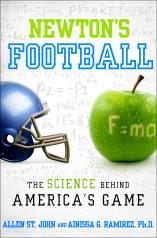The developers for EA Sports’ video game Madden NFL 13 have 10 million lines of code at their disposal, but when they need to capture the movement of a football, they spend hours in offices and hallways and even on the lawns outside, dropping, bouncing and rolling footballs and then poring over the results. “If I throw a spherical ball in the air, I know exactly where it’s going,” says software engineer Ryan Morse. “If you throw a football in the air and it lands, it can go 30 different ways.”
“It’s more like 30 thousand. Or 30 billion,” adds physicist Toan Pham, the group’s technical director.
The reason a football bounces so strangely is because of its shape. A football is a prolate spheroid, and it’s shaped that way because that’s also the shape of an inflated pig’s bladder, which is what the first footballs were made of. Soccer balls were also made of pig’s bladders, but as soon as technology permitted, those balls got rounder, which made them easier to kick. But as the football evolved — and was constructed of cowhide and rubber — it got even more prolate, which made it easier to carry and easier to throw. And much harder to pick up when it bounces on the ground.
What this oddly shaped ball — and the physics behind it — lends to our national pastime is randomness. The randomness of a bouncing ball adds an element of uncertainty that coaches and players try mightily to minimize. Indeed, the unpredictable bounce is powerful enough to determine which teams will be vying for a trip to the Super Bowl and which teams will be watching the playoffs from the comfort of their couches.
Consider the fumble. Forcing a fumble is a skill that can be practiced and learned. Some teams are better at it than others. But once the ball hits the ground, all bets are off. It will elude the grasp of a future Hall of Famer and leap into the arms of a sub from the taxi squad. The subsequent change of possession — or lack thereof — from a fumble can result in a swing of 14 points or more. In a league where the average margin of victory is 12 points, it’s no exaggeration to suggest that one random bounce can determine the outcome of a game.
That’s what happened with DeSean Jackson’s game-winning punt return against the Giants in 2010. The ball took a lucky bounce after the Eagles’ return man fumbled it, and Jackson was able to scoop it up and run for an improbable touchdown, a play selected by NFL fans as the greatest of all time.
The random bounce of the ball can even change the course of history.

In the 2012 regular season, the San Francisco 49ers recovered 23 of 37 fumbles for a 62% success rate. The Detroit Lions recovered only 9 of 24, or 37%. Their success at collecting bouncing footballs is one of the reasons the 49ers went 11-4-1 and made it all the way to the Super Bowl. As for the Lions, they ended up a disappointing 4-12.
Just as it does in the world of science, where it drives everything from evolution to cryptography, randomness is a powerful, disruptive force in football. Coaches and players work all week to devise a game plan and execute it to perfection. Then on Sunday afternoon, the pigskin hits the turf and squirts this way instead of that. The fans erupt with frenzied cheers. Viewers at home watch the instant replay in disbelief. And the scoreboard tells a story that borders on the unbelievable.
All because of a bouncing ball.
From the book Newton’s Football, by Allen St. John and Ainissa G. Ramirez, Ph.D. Copyright (c) 2013 by Allen St. John and Ainissa G. Ramirez, Ph.D. Reprinted by arrangement with Random House. All rights reserved.

